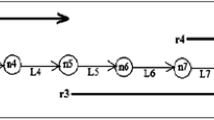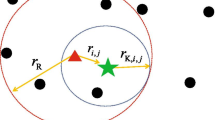Abstract
Wireless ad-hoc networks have seen much attention in recent years, for the numerous benefits they offer. There are still a number of open research questions regarding these networks, and this paper addresses the question of which duplexing, multiplexing, and multiple access (D/M/MA) techniques are preferable in ad hoc networks. These techniques have substantial impact on network performance, yet this particular topic has seen surprisingly little attention. In this paper, we investigate D/M/MA techniques in ad-hoc networks and specifically address how to allocate time/frequency resources to improve network performance. We provide a comparison of time, frequency, and time-frequency schemes in terms of a number of features, including throughput, relative range and capacity. To keep the analyses tractable, we conduct our study using two limiting or “extreme” topologies: full mesh and pure relay networks. Our results show that for a peak power constraint, in terms of data rate, range, or capacity, continuous single-carrier waveforms are superior to bursted multi-carrier waveforms, and these schemes are attained with appropriate application of “hybrid” time-frequency division. Latency and throughput simulation results are provided for mesh networks, and analytical signal-to-noise-plus-interference ratio and simulation results for relay networks are also provided, to support our theoretically-based claims.










Similar content being viewed by others
Notes
Code division multiple access (CDMA), which requires spectral spreading beyond the bandwidth needed for data transmission, is widely used in military and covert communication systems, for its resistance to interference, multipath fading and physical layer security [35]. It is used in commercial cellular systems as well. Although CD is worth study in ad hoc networks, for reasons of length we do not discuss CDMA further in this paper.
Note this definition of MA could also be viewed as demultiplexing at the receiver.
If transmission data rates are not identical in the two directions, we would separate the analysis into “uplink” and “downlink” and apply the different data rates to the two directions; although this clearly affects results, our subsequent attention to the more realistic topologies will assume equal data rates for all nodes, hence we focus on this case.
The actual relationship between bit rate and bandwidth will depend on the specific modulation, coding, pulse shape filter, etc. For simplicity, we use this approximation here. For linear modulation, bit rate and bandwidth will always be proportional.
Schemes in different topologies are distinguished by abbreviations, e.g., “MT” for mesh time division, “RTF” for relay time-frequency division.
We note for the geometrically-astute reader that in networks with more than 3 nodes, all link distances cannot be equal, but on a per-link basis this does not affect our conclusions.
References
Adams, S., Cain, B., Olds, K., & Griessler, P. (November, 2008). A comparison of FDD and TDD/TDMA architectures for airborne backbone network traffic. Proceedings of MILCOM ’08. (pp. 17–19) San Diego, CA.
Aggelou, G. (2005). Mobile Ad Hoc Networks. New York, NY: McGraw-Hill.
Akyildiz, I. F., Wang, X., & Wang, W. (March, 2004). Wireless mesh networks: A survey. Journal of Computer Networks (Elsevier).
Andrews, J. G., Ganti, R. K., Haenggi, M., Jindal, N., & Weber, S. (2010). A primer on spatial modeling and analysis in wireless Networks. Communications Magazine, IEEE, 48(11), 156–163.
Andrews, J. G., Weber, S., & Haenggi, M. (2007). Ad Hoc networks: To spread or not to spread? Communications Magazine, IEEE, 45(12), 84–91.
Broch, J., Maltz, D. A., Johnson, D. B., Hu, Y., & Jetcheva, J. (1998). A performance comparison of multi-hop wireless Ad Hoc network routing protocols. Dallas, Tx: MobiCom.
Camp, J. D., & Knightly, E. W. (2008). The IEEE 802.11s extended service set mesh networking standard. Communications Magazine, IEEE, 46(8), 120–125.
Chan, P. W. C., et al. (2006). The evolution path of 4G Networks: FDD or TDD? IEEE Communications Magazine, 44(12), 42–50.
Comaniciu, C., & Poor, H. V. (2007). On energy-efficient cross-layer design: Joint power control and routing for Ad Hoc networks. EURASIP Journal on Wireless Communications and Networking, Article ID 60706, Volume.
Couch, L. W. (2007). Digital and analog communication systems (7th ed.). Upper Saddle River, NJ: Prentice Hall.
Cover, T. M., & Thomas, J. A. (2006). Elements of information theory (2nd ed.). Hoboken, NJ: Wiley Publishers.
Ferrari, G., Malvassori, S. A., & Tonguz, O. K. (2008). On physical layer-oriented routing with power control in Ad Hoc Wireless Networks. Proceedings of IET Communications, 2(2), 306–319.
Griessler, P., Cain, J. B., & Hanks, R. (2007) Modeling architecture for DTDMA channel access protocol for mobile network nodes using directional Antennas. Proceedings of MILCOM ’07, Orlando, FL, 29–31 October.
Gupta, P., & Kumar, P. R. (2000). The capacity of wireless networks. IEEE Transactions on Information Theory, 46, 388–404.
Haenggi, M., & Puccinelli, D. (2005). Routing in Ad Hoc networks: A case for long Hops. Communications Magazine, IEEE, 43(10), 93–101.
Information theory for mobile Ad Hoc networks (ITMANET), DARPA IPTO program, http://www.darpa.mil/ipto/programs/itmanet/itmanet.asp, December 2008.
Karras, K., Kyritsis, T., Amirfeiz, M. A., & Baiotti, S. (2008) Aeronautical Mobile Ad Hoc Networks. In Proceedings of 14th European wireless conference, Prague, Czech Republic, 22–25 June.
Laneman, J. N., Wornell, G. W., & Tse, D. N. C. (2001). An efficient protocol for realizing cooperative diversity in wireless networks. IEEE International Symposium on Information Theory (p. 294).
Li, F., & Wang, Y. (2007). Routing in vehicular Ad Hoc networks: A survey. IEEE Vehicular Technology Magazine, 2(2), 12–22.
Matolak, D. W. (Nov., 2008). Duplexing, multiplexing, and multiple access: A comparative analysis For mesh networks. In Proceedings of MILCOM (pp. 17–19). San Diego, CA.
Mehrotra, A. (1997). GSM system engineering. Boston, MA: Artech House.
Muqattash, A., Krunz, M., & Ryan, W. E. (2003). Solving the near-far problem in CDMA-based Ad Hoc networks. Elsevier Journal Ad Hoc Networks, 1(4), 435–453.
Nosratinia, A., El Hunter, T., & Hedayat, A. (2004). Cooperative communication in wireless networks. IEEE Communications Magazine, 42(10), 74–80.
Otyakmaz, A., Schoenen, R., Dreier, S., & Walke, B.H. (2008). Parallel operation of half- and full-duplex FDD in future multi-Hop mobile radio networks. In Proceedings of 14th European Wireless Conference, Prague, Czech Republic, 22–25 June.
Panichpapiboon, S., Ferrari, G., & Tonguz, O. K. (2010). Connectivity of Ad Hoc wireless networks: An alternative to graph-theoretic approaches. Wireless Network, 16(3), 793–811.
Proakis, J. G. (2008). Digital communications (5th ed.). New York, NY: McGraw-Hill.
Rappaport, T. S. (2002). Wireless communications, principles and practice (2nd ed.). Upper Saddle River, NJ: Prentice-Hall.
Rokitansky, C., Ehammer, M., Graupl, T., Schnell, M., Brandes, S., Gligorevic, S., Rihacek, C., Sajatovic, M. (2007). B-AMC–A system for future broadband aeronautical multicarrier communications in the L Band. In Proceedings of IEEE digital Avionics systems conference, Dallas, TX, 21–25 October.
Rutagemwa, H., Willink, T. J., & Li, L. (2010). Modeling and performance analysis of multihop cooperative wireless networks. Vehicular Technology, IEEE Transactions, 59(6), 3057–3069.
Van der Schaar, M., & Shankar, S. (2005). Cross-Layer wireless multimedia transmission: Challenges, principles, and new paradigms. IEEE Wireless Communications Magazine, 12(4), 50–58.
Schiavone L. (2004). Airborne networking–approaches and challenges. Proceedings of MILCOM ’04, Monterey, CA, Oct. 31–Nov. 3.
Sethu, H., & Gerety, T. (2010). A new distributed topology control algorithm for wireless environments with non-uniform path loss and multipath propagation. Elsevier Journal Ad Hoc Networks, 8(3), 280–294.
Stamatiou, K., & Proakis, J. G. (2008). Assessing the impact of physical layer techniques on Ad Hoc network performance. Physical Communication Journal (Elsevier), 1, 84–91.
Stepanov, I., & Rothermel, K. (2008). On the impact of a more realistic physical layer on MANET simulations results. Elsevier Journal Ad Hoc Networks, 6(1), 61–78.
Stuber, G. L. (2000). Principles of mobile communication (2nd ed.). Berlin: Springer.
Tonguz, O. K., & Ferrari, G. (2006). Ad Hoc wireless networks (1st ed.). UK: Wiley.
Tu, H. D., & Shimamoto, S. (2009). Mobile Ad-Hoc network based relaying data system for Oceanic flight routes in aeronautical communications. IJCNC, 1(1), 33–44.
Van Hook, D. J., Yeager, M. O., Laird, J. D. (2005). Automated topology control for wideband directional links in airborne military networks. Proceedings of MILCOM ’05 Atlantic City, NJ, pp. 17–20 October
Warty, C. (March 2010). Cooperative communication for multiple satellite network. In Proceedings of IEEE Aerospace Conference (pp. 6–13). Big Sky, MT.
Xue, F., & Kumar, P. R. (2004). The number of neighbors needed for connectivity of Wireless Networks. Wireless Networks (ACM Journal), 10(2), 169–181.
Zhang, Q., & Matolak, D. W. (March, 2010). Analysis of relay network duplexing, multiplexing, & multiple access: Application to aeronautical Networks. In Proceedings of IEEE Aerospace Conference. (pp. 6–13). Big Sky, MT.
Zhang, Q., & Matolak, D. W. (Nov. 2011). Multiple access in Mesh and Relay Networks: continuous single-carrier waveforms are superior to bursted multi-carrier waveforms. In Proceedings of IEEE MILCOM 2011 (pp. 890–895).
Zhang, Q., Matolak, D. W. (Nov. 2012). Comparing duplexing, multiplexing, and multiple access techniques in Mesh, Relay, and Ad-hoc Networks. submitted to RadioEngineering Journal.
Author information
Authors and Affiliations
Corresponding author
Rights and permissions
About this article
Cite this article
Zhang, Q., Matolak, D.W. Ad Hoc Network Duplexing, Multiplexing, and Multiple Access: Canonical Results for Two Limiting Topologies. Wireless Pers Commun 75, 965–985 (2014). https://doi.org/10.1007/s11277-013-1402-7
Published:
Issue Date:
DOI: https://doi.org/10.1007/s11277-013-1402-7




